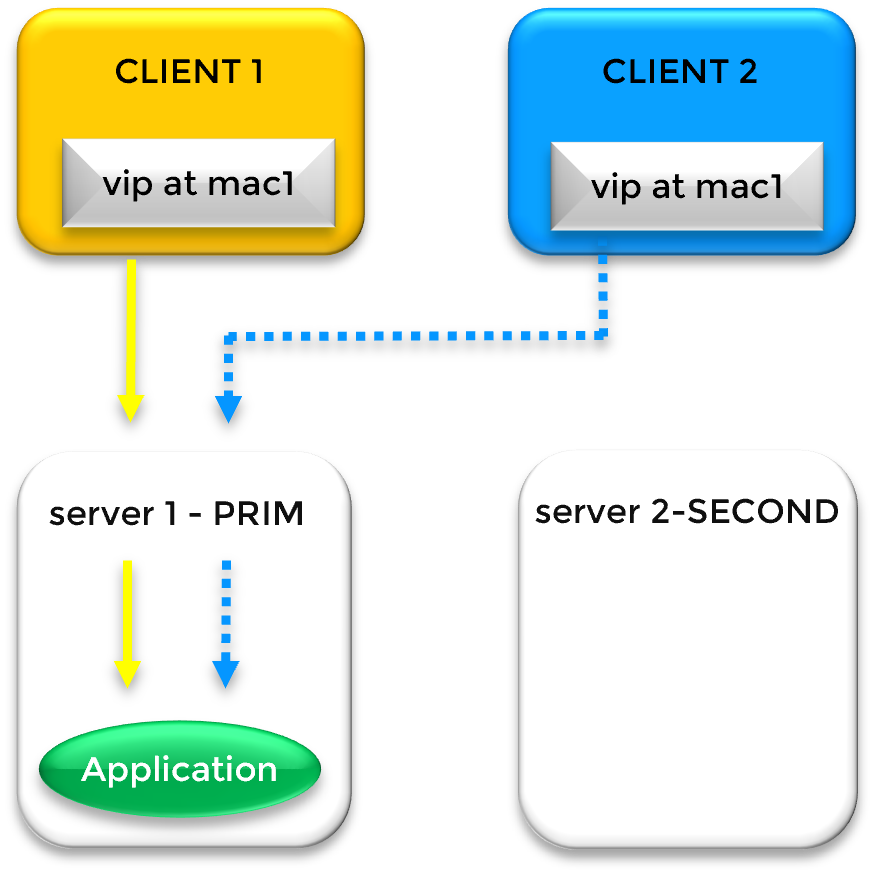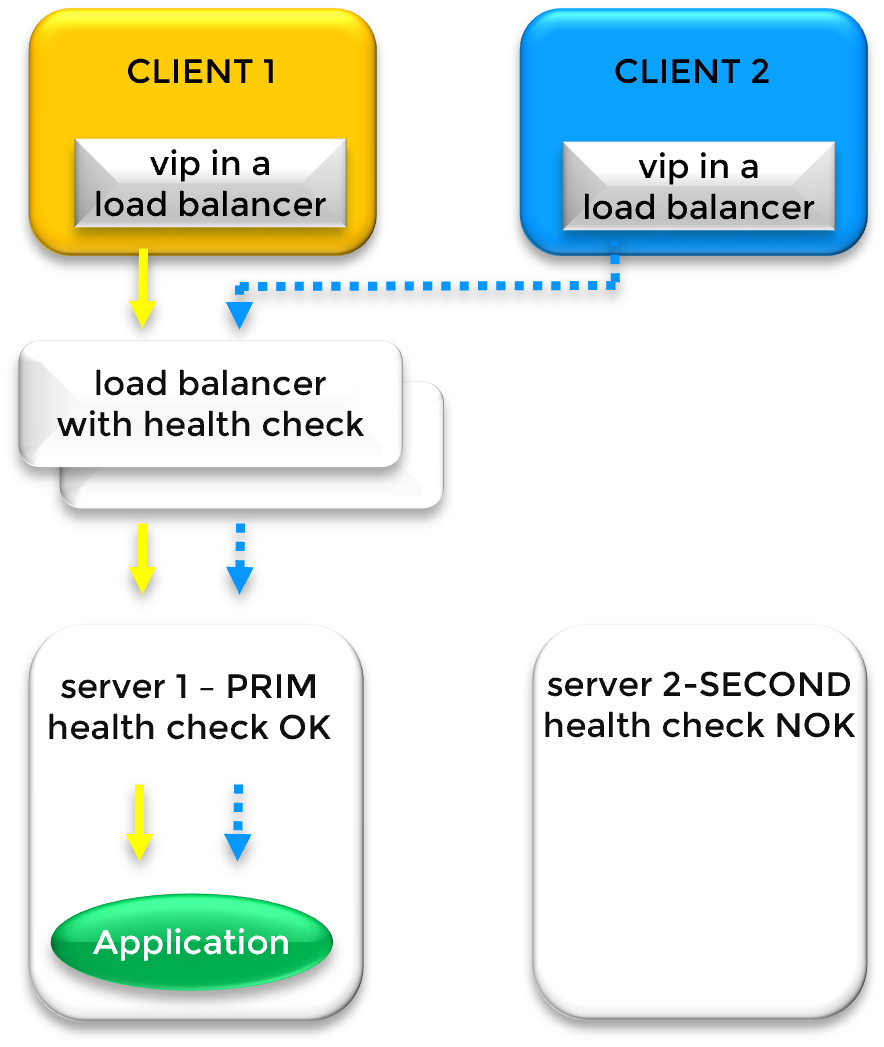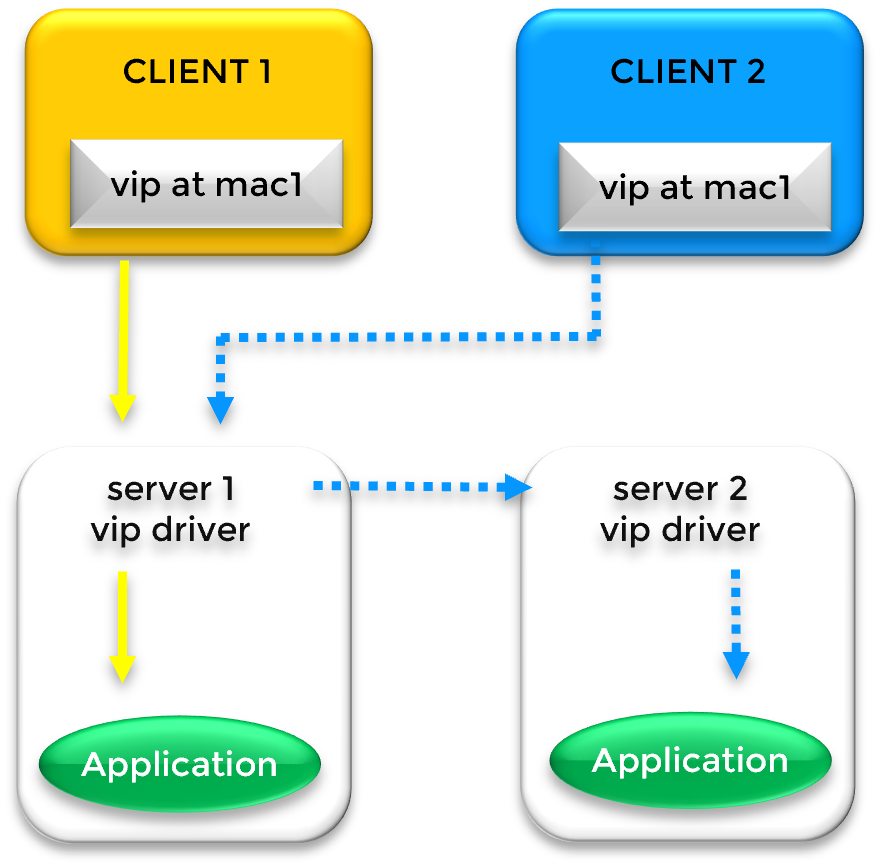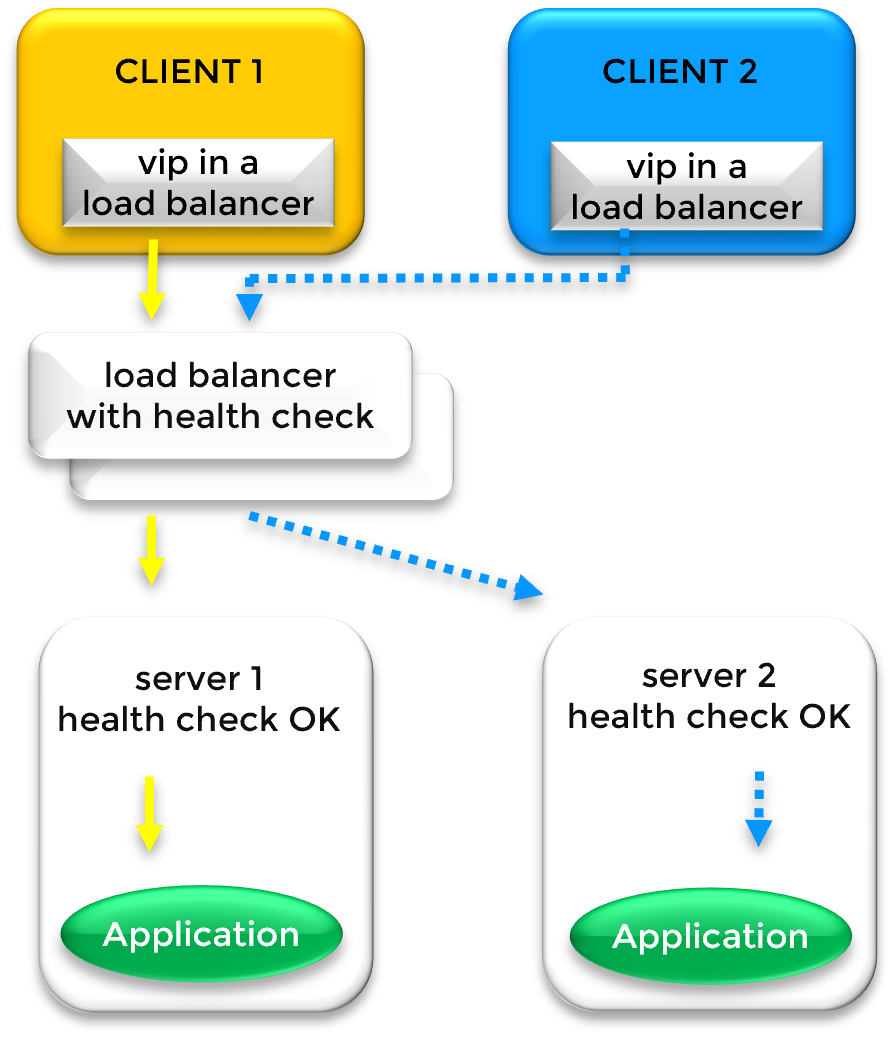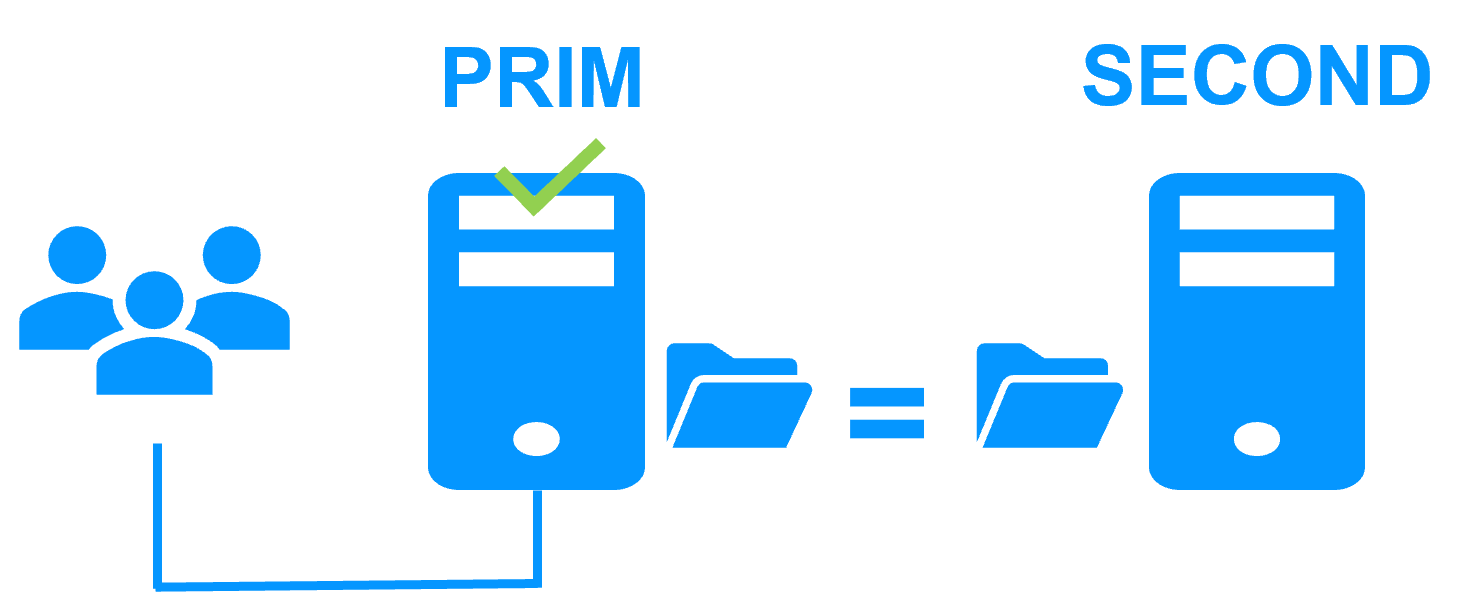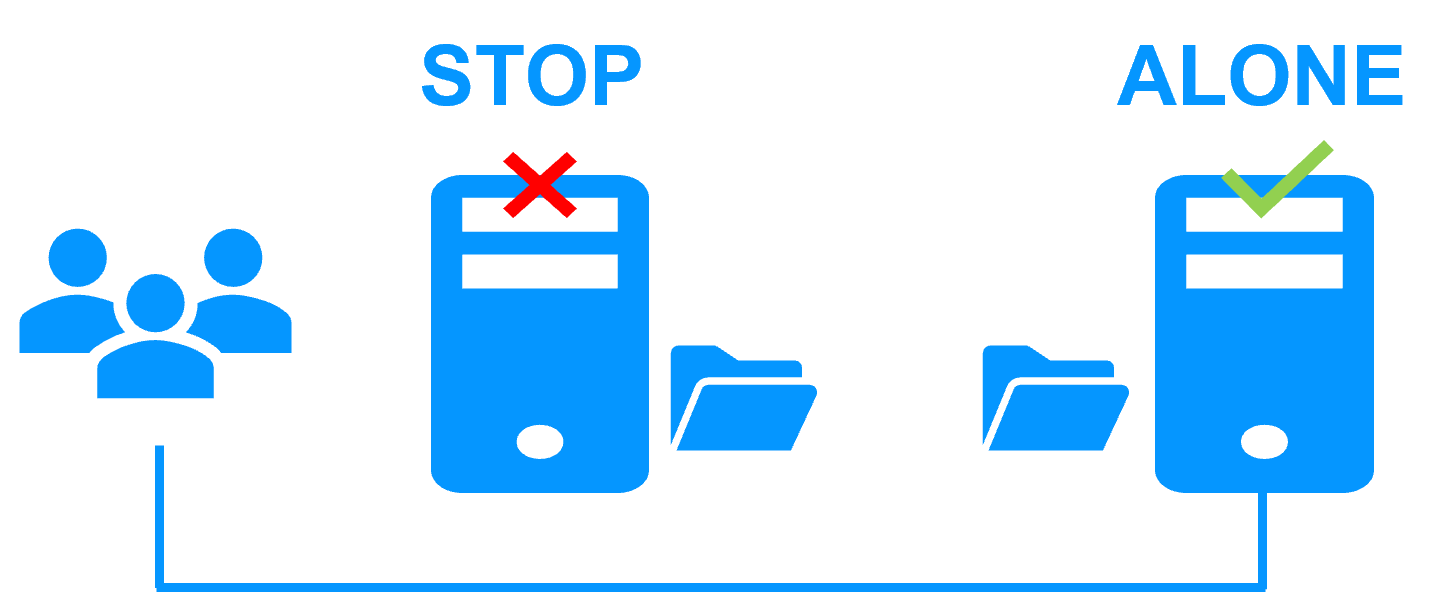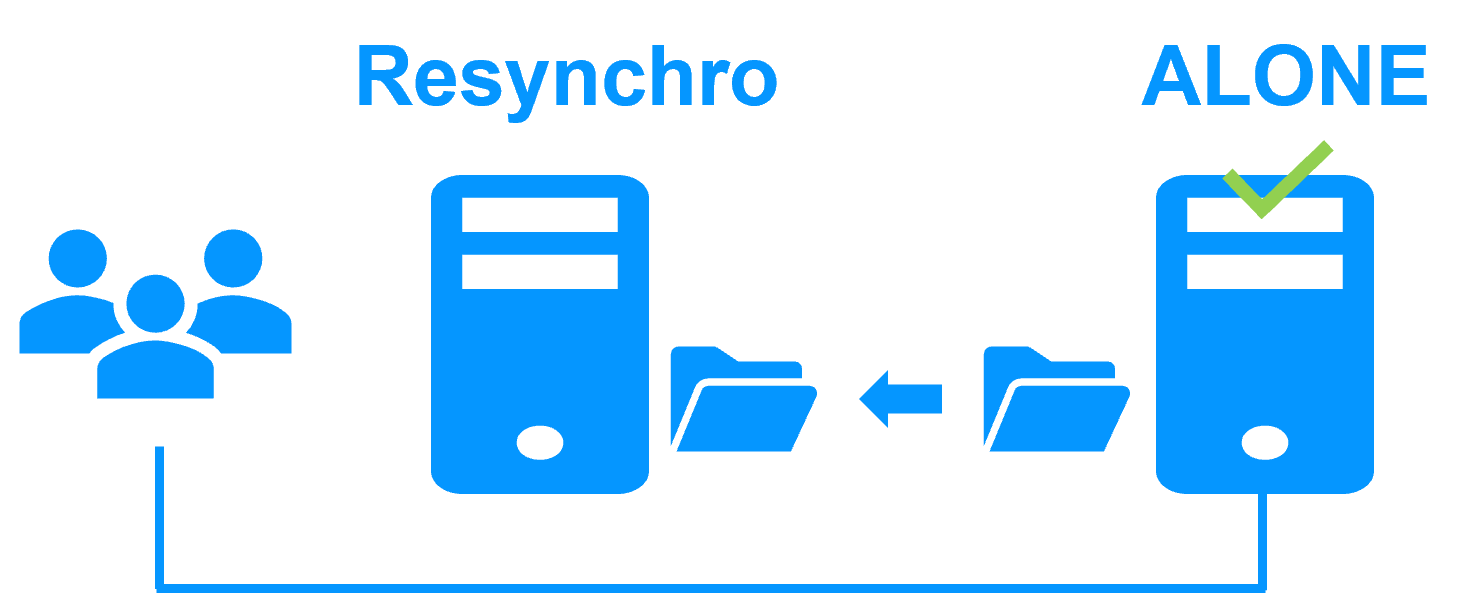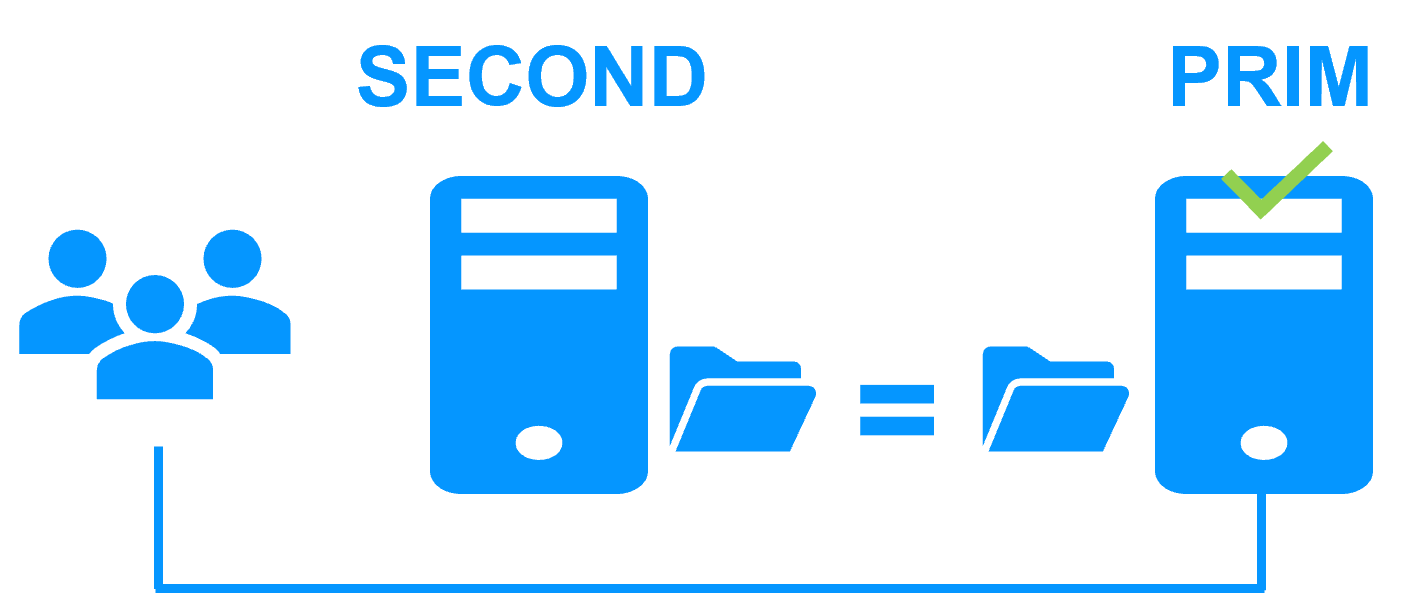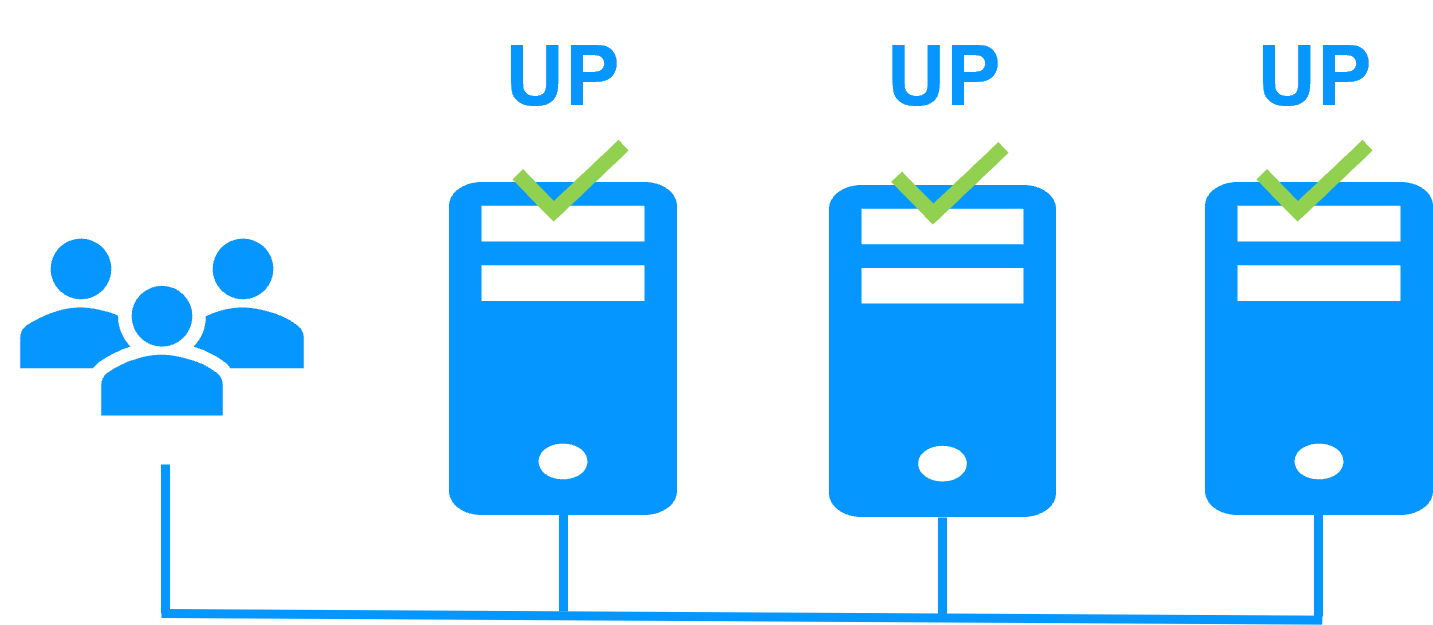How a virtual IP address works (Windows/Linux)?
Evidian SafeKit
How a primary/secondary virtual IP address works in the same subnet?
Case of a mirror cluster with 2 Windows or Linux servers
When both servers of a mirror cluster are in the same subnet, the virtual IP address is set on the Ethernet card of the primary server (through IP aliasing). The virtual IP address is a third IP address coming in addition to the two physical IP addresses of server 1 and server 2. Note that with SafeKit, several virtual IP addresses can be set in the cluster on the same Ethernet card or on different Ethernet cards.
If server 1 is the primary server, then the virtual IP address is associated to the Ethernet MAC address of server 1 in the clients ARP caches: mac1 in the figure. If there is a failure of server 1 and a failover on server 2, SafeKit automatically sends gratuitous ARP to reroute clients ARP caches with the Ethernet address mac2 of server 2. Thus, clients are reconnected to server 2 running the application which has been restarted on this server by the SafeKit clustering mechanisms.
When two servers are in remote sites, the previous virtual IP address algorithms are working if they are connected in the same subnet through an extended LAN/VLAN. This is the simplest use case for remote sites.
How a primary/secondary virtual IP address works in different subnets?
Case of a mirror cluster with 2 Windows or Linux servers
If the servers are in differents subnets, the virtual IP address can be set at the level of a load balancer. The load balancer is configured with the two physical IP addresses of the two servers in their respective subnets. And the load balancer routes the traffic according a health check to servers.
The health check is based on a URL managed by SafeKit servers and answering OK or NOT FOUND according the status of a server. If the server is SECOND, the SafeKit health check returns NOT FOUND. Thus no traffic is sent by the load balancer to the secondary server. And if the server is PRIM, then the SafeKit health check returns OK. Thus all the traffic is sent by the load balancer to the primary server. In case of failover, SafeKit changes its answers to the health check. Thus the traffic of the load balancer is rerouted.
This implementation is the one used in SafeKit mirror-like solutions in the Cloud: Amazon AWS, Microsoft Azure and Google GCP.
Please note that SafeKit does not provide a load balancer; it only offers health checks. The load balancer must be supplied by the network infrastructure between the two subnets.
If needed, it can be discussed with the network team whether, instead of setting up a load balancer, an extended LAN could be configured between the two subnets. Moreover, when using a load balancer, it is essential to ensure that the application supports clients connecting via the load balancer's virtual IP address and that it properly handles connections arriving through the translated physical IP address assigned by the load balancer.
This issue does not arise with an extended LAN, which also provides sufficient bandwidth and appropriate latency for real-time synchronous replication without data loss.
How a load balanced virtual IP address works in the same subnet?
Case of a farm cluster with 2 Windows or Linux servers
In a load balancing farm cluster, a virtual IP address is required to load balance clients requests and to reroute clients in case of failover. In this example, we consider only two servers but the solution works with more than two servers.
When both servers of the cluster are in the same subnet, the virtual IP address is set on the Ethernet card of both servers (IP aliasing).
In the ARP cache of clients, the virtual IP address is associated to the Ethernet MAC address of one server: mac1 of server1 in the figure. A filter inside the kernel of server 1 receives the traffic and split it according the identity of the client packets (client IP address, client TCP port).
If there is a failure of server 1, SafeKit sends gratuitous ARP to reroute clients ARP caches with the Ethernet address mac2 of server 2. Thus, clients are reconnected to server 2.
When two servers are in remote sites, the previous virtual IP address algorithms are working if they are connected in the same subnet through an extended LAN/VLAN. This is the simplest use case for remote sites.
How a load balanced virtual IP address works in different subnets?
Case of a farm cluster with 2 Windows or Linux servers
If the servers are in differents subnets, the virtual IP address can be set at the level of a load balancer. The load balancer is configured with the two physical IP addresses of the two servers in their subnets. And the load balancer routes the traffic according load balancing rules (client IP address, client TCP port) and according a health check to servers.
The health check is based on a URL managed by SafeKit servers and answering OK or NOT FOUND according the status of a server. If the server is UP, the SafeKit health check returns OK, else NOT FOUND. In case of failover, SafeKit does not answer anymore OK to the health check on the failed server. Thus the traffic of the load balancer is rerouted.
This implementation is the one used in SafeKit farm-like solutions in the Cloud: Amazon AWS, Microsoft Azure and Google GCP.
Note that there is another solution by rerouting at the DNS level. But this solution is not working in most cases because the prerequisite is that clients makes a DNS resolution after a failover to be rerouted to the new server. Most often, they do not and continue their execution with the IP address resolved when they started.
Step 1. Real-time replication
Server 1 (PRIM) runs the application. Clients are connected to a virtual IP address. SafeKit replicates in real time modifications made inside files through the network.
The replication is synchronous with no data loss on failure contrary to asynchronous replication.
You just have to configure the names of directories to replicate in SafeKit. There are no pre-requisites on disk organization. Directories may be located in the system disk.
Step 2. Automatic failover
When Server 1 fails, Server 2 takes over. SafeKit switches the virtual IP address and restarts the application automatically on Server 2.
The application finds the files replicated by SafeKit uptodate on Server 2. The application continues to run on Server 2 by locally modifying its files that are no longer replicated to Server 1.
The failover time is equal to the fault-detection time (30 seconds by default) plus the application start-up time.
Step 3. Automatic failback
Failback involves restarting Server 1 after fixing the problem that caused it to fail.
SafeKit automatically resynchronizes the files, updating only the files modified on Server 2 while Server 1 was halted.
Failback takes place without disturbing the application, which can continue running on Server 2.
Step 4. Back to normal
After reintegration, the files are once again in mirror mode, as in step 1. The system is back in high-availability mode, with the application running on Server 2 and SafeKit replicating file updates to Server 1.
If the administrator wishes the application to run on Server 1, he/she can execute a "swap" command either manually at an appropriate time, or automatically through configuration.
More information on power outage and network isolation in a cluster.
Why a replication of a few Tera-bytes?
Resynchronization time after a failure (step 3)
- 1 Gb/s network ≈ 3 Hours for 1 Tera-bytes.
- 10 Gb/s network ≈ 1 Hour for 1 Tera-bytes or less depending on disk write performances.
Alternative
- For a large volume of data, use external shared storage.
- More expensive, more complex.
Why a replication < 1,000,000 files?
- Resynchronization time performance after a failure (step 3).
- Time to check each file between both nodes.
Alternative
- Put the many files to replicate in a virtual hard disk / virtual machine.
- Only the files representing the virtual hard disk / virtual machine will be replicated and resynchronized in this case.
Why a failover ≤ 32 replicated VMs?
- Each VM runs in an independent mirror module.
- Maximum of 32 mirror modules running on the same cluster.
Alternative
- Use an external shared storage and another VM clustering solution.
- More expensive, more complex.
Why a LAN/VLAN network between remote sites?
- Automatic failover of the virtual IP address with 2 nodes in the same subnet.
- Good bandwidth for resynchronization (step 3) and good latency for synchronous replication (typically a round-trip of less than 2ms).
Alternative
- Use a load balancer for the virtual IP address if the 2 nodes are in 2 subnets (supported by SafeKit, especially in the cloud).
- Use backup solutions with asynchronous replication for high latency network.
Virtual IP address in a farm cluster
On the previous figure, the application is running on the 3 servers (3 is an example, it can be 2 or more). Users are connected to a virtual IP address.
The virtual IP address is configured locally on each server in the farm cluster.
The input traffic to the virtual IP address is received by all the servers and split among them by a network filter inside each server's kernel.
SafeKit detects hardware and software failures, reconfigures network filters in the event of a failure, and offers configurable application checkers and recovery scripts.
Load balancing in a network filter
The network load balancing algorithm inside the network filter is based on the identity of the client packets (client IP address, client TCP port). Depending on the identity of the client packet input, only one filter in a server accepts the packet; the other filters in other servers reject it.
Once a packet is accepted by the filter on a server, only the CPU and memory of this server are used by the application that responds to the request of the client. The output messages are sent directly from the application server to the client.
If a server fails, the SafeKit membership protocol reconfigures the filters in the network load balancing cluster to re-balance the traffic on the remaining available servers.
Stateful or stateless applications
With a stateful application, there is session affinity. The same client must be connected to the same server on multiple TCP sessions to retrieve its context on the server. In this case, the SafeKit load balancing rule is configured on the client IP address. Thus, the same client is always connected to the same server on multiple TCP sessions. And different clients are distributed across different servers in the farm.
With a stateless application, there is no session affinity. The same client can be connected to different servers in the farm on multiple TCP sessions. There is no context stored locally on a server from one session to another. In this case, the SafeKit load balancing rule is configured on the TCP client session identity. This configuration is the one which is the best for distributing sessions between servers, but it requires a TCP service without session affinity.
New application (real-time replication and failover)
- Windows (mirror.safe)
- Linux (mirror.safe)
New application (network load balancing and failover)
Database (real-time replication and failover)
- Microsoft SQL Server (sqlserver.safe)
- PostgreSQL (postgresql.safe)
- MySQL (mysql.safe)
- Oracle (oracle.safe)
- MariaDB (sqlserver.safe)
- Firebird (firebird.safe)
Web (network load balancing and failover)
- Apache (apache_farm.safe)
- IIS (iis_farm.safe)
- NGINX (farm.safe)
Full VM or container real-time replication and failover
- Hyper-V (hyperv.safe)
- KVM (kvm.safe)
- Docker (mirror.safe)
- Podman (mirror.safe)
- Kubernetes K3S (k3s.safe)
Amazon AWS
- AWS (mirror.safe)
- AWS (farm.safe)
Google GCP
- GCP (mirror.safe)
- GCP (farm.safe)
Microsoft Azure
- Azure (mirror.safe)
- Azure (farm.safe)
Other clouds
- All Cloud Solutions
- Generic (mirror.safe)
- Generic (farm.safe)
Physical security (real-time replication and failover)
- Milestone XProtect (milestone.safe)
- Nedap AEOS (nedap.safe)
- Genetec SQL Server (sqlserver.safe)
- Bosch AMS (hyperv.safe)
- Bosch BIS (hyperv.safe)
- Bosch BVMS (hyperv.safe)
- Hanwha Vision (hyperv.safe)
- Hanwha Wisenet (hyperv.safe)
Siemens (real-time replication and failover)
- Siemens Siveillance suite (hyperv.safe)
- Siemens Desigo CC (hyperv.safe)
- Siemens Siveillance VMS (SiveillanceVMS.safe)
- Siemens SiPass (hyperv.safe)
- Siemens SIPORT (hyperv.safe)
- Siemens SIMATIC PCS 7 (hyperv.safe)
- Siemens SIMATIC WinCC (hyperv.safe)
| VM HA with the SafeKit Hyper-V or KVM module | Application HA with SafeKit application modules |
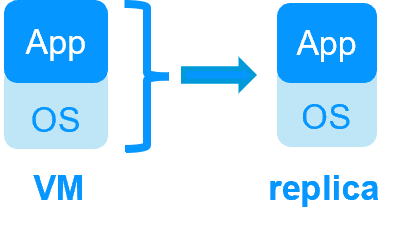 |
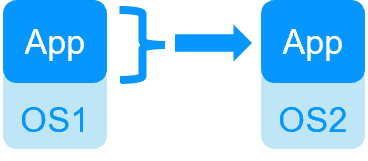 |
| SafeKit inside 2 hypervisors: replication and failover of full VM | SafeKit inside 2 virtual or physical machines: replication and failover at application level |
| Replicates more data (App+OS) | Replicates only application data |
| Reboot of VM on hypervisor 2 if hypervisor 1 crashes Recovery time depending on the OS reboot VM checker and failover (Virtual Machine is unresponsive, has crashed, or stopped working) |
Quick recovery time with restart of App on OS2 if crash of server 1 Around 1 mn or less (see RTO/RPO here) Application checker and software failover |
| Generic solution for any application / OS | Restart scripts to be written in application modules |
| Works with Windows/Hyper-V and Linux/KVM but not with VMware | Platform agnostic, works with physical or virtual machines, cloud infrastructure and any hypervisor including VMware |
| SafeKit with the Hyper-V module or the KVM module | Microsoft Hyper-V Cluster & VMware HA |
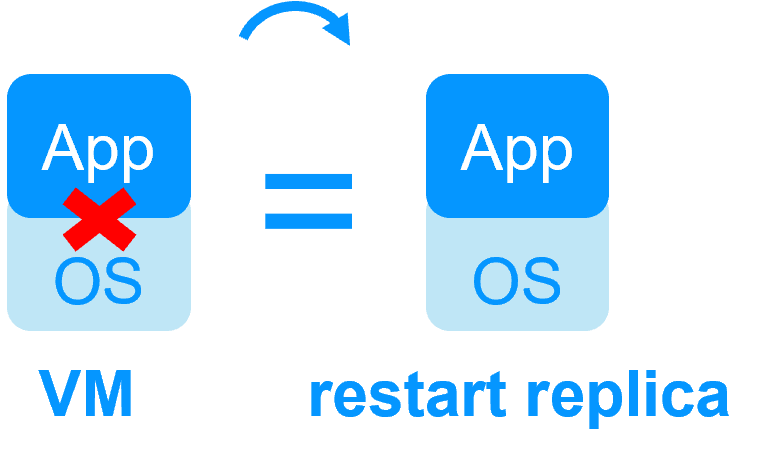 |
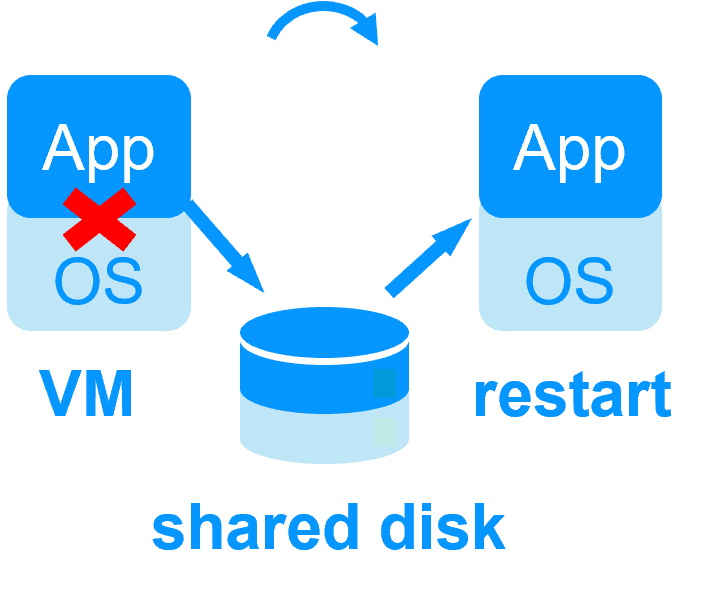 |
 No shared disk - synchronous real-time replication instead with no data loss No shared disk - synchronous real-time replication instead with no data loss |
 Shared disk and specific extenal bay of disk Shared disk and specific extenal bay of disk |
 Remote sites = no SAN for replication Remote sites = no SAN for replication |
 Remote sites = replicated bays of disk across a SAN Remote sites = replicated bays of disk across a SAN |
 No specific IT skill to configure the system (with hyperv.safe and kvm.safe) No specific IT skill to configure the system (with hyperv.safe and kvm.safe) |
 Specific IT skills to configure the system Specific IT skills to configure the system |
| Note that the Hyper-V/SafeKit and KVM/SafeKit solutions are limited to replication and failover of 32 VMs. | Note that the Hyper-V built-in replication does not qualify as a high availability solution. This is because the replication is asynchronous, which can result in data loss during failures, and it lacks automatic failover and failback capabilities. |
Evidian SafeKit mirror cluster with real-time file replication and failover |
|
3 products in 1
More info >
 |
|
Very simple configuration
More info >
 |
|
Synchronous replication
More info >
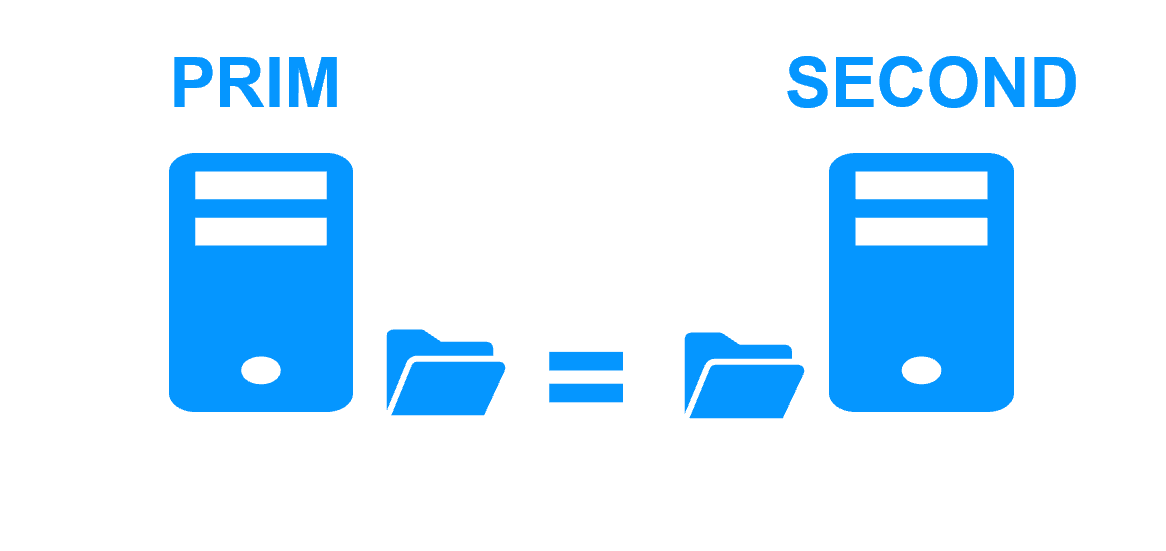 |
|
Fully automated failback
More info >
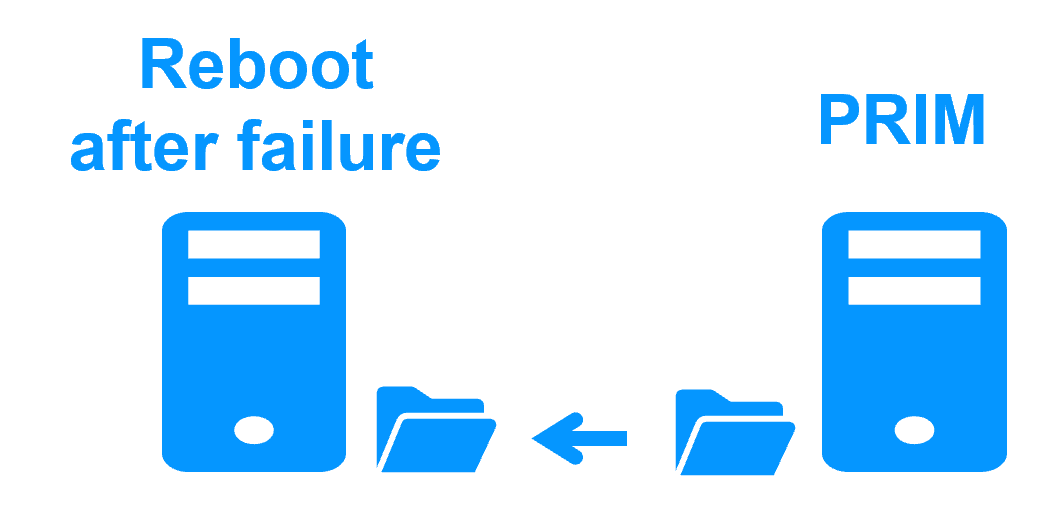 |
|
Replication of any type of data
More info >
 |
|
File replication vs disk replication
More info >
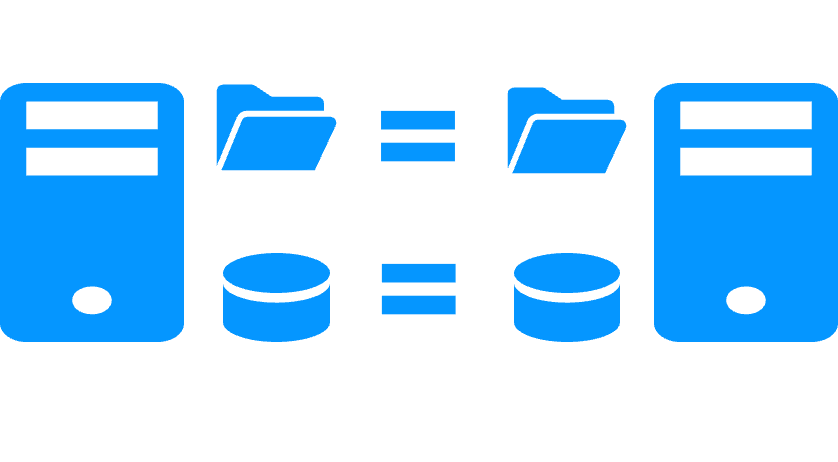 |
|
File replication vs shared disk
More info >
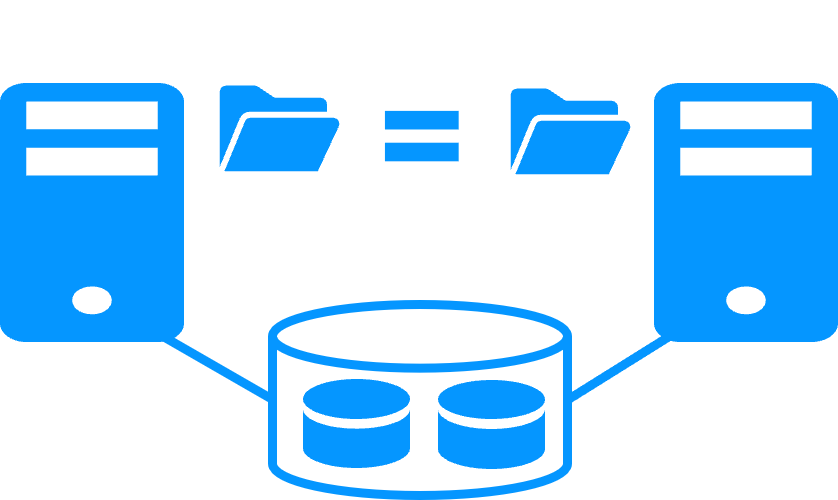 |
|
Remote sites and virtual IP address
More info >
 |
|
Quorum and split brain
More info >
 |
|
Active/active cluster
More info >
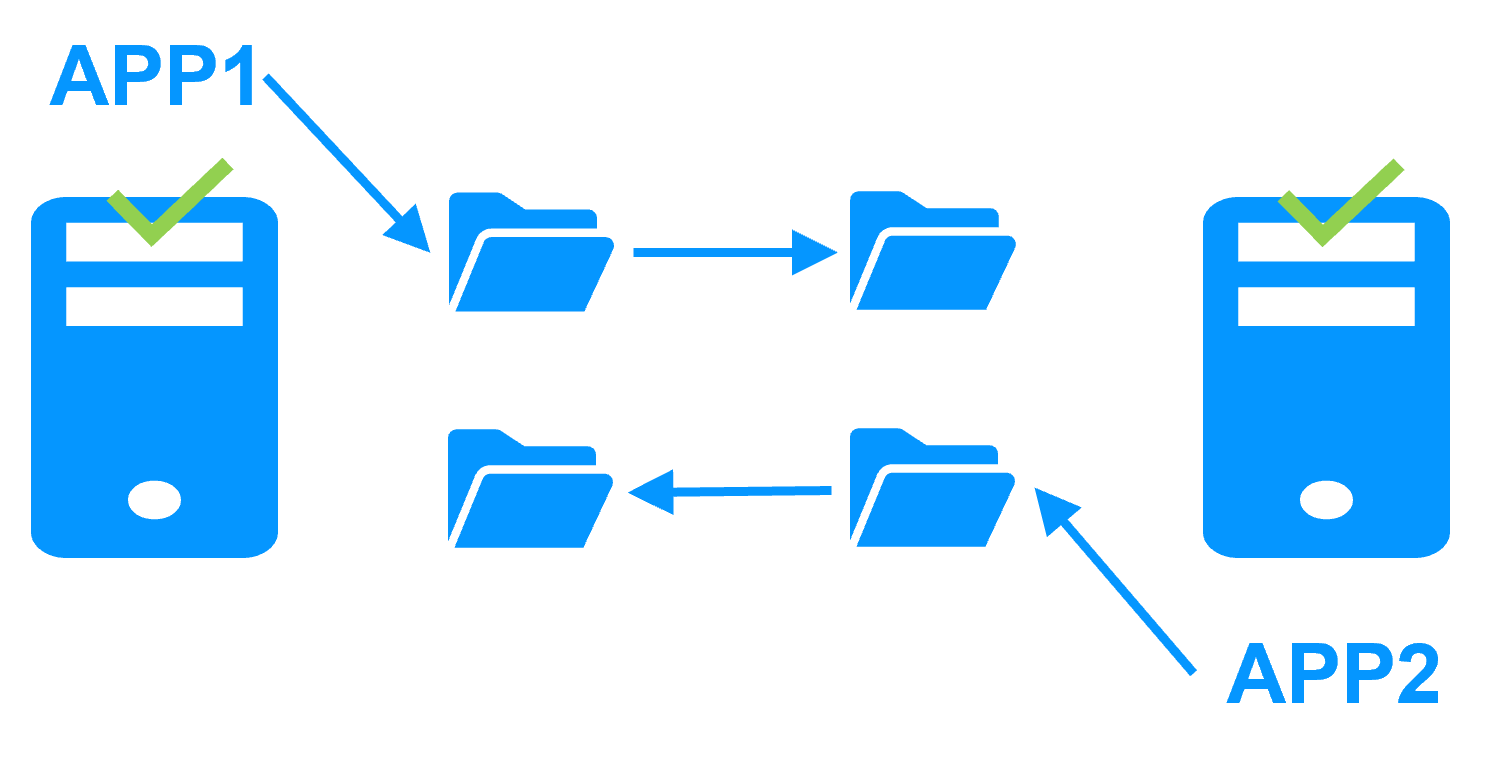 |
|
Uniform high availability solution
More info >
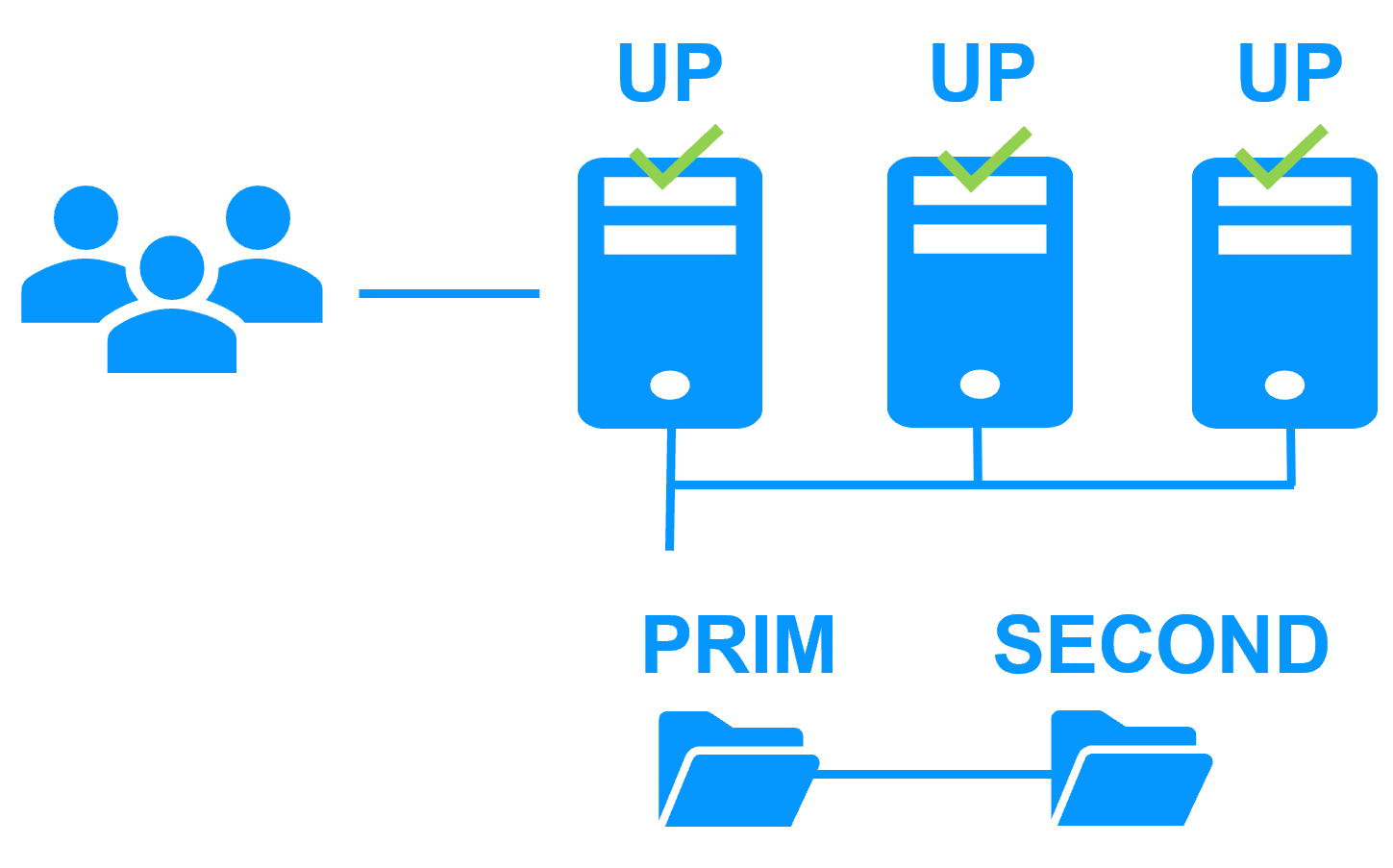 |
|
RTO / RPO
More info >
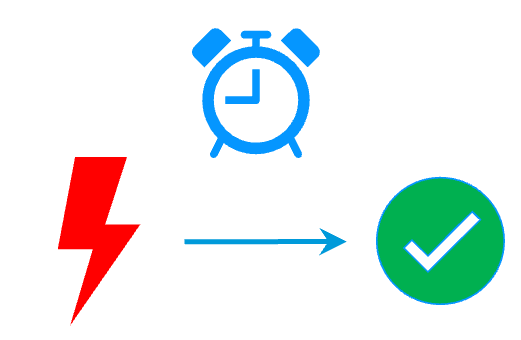 |
|
Evidian SafeKit farm cluster with load balancing and failover |
|
No load balancer or dedicated proxy servers or special multicast Ethernet address
More info >
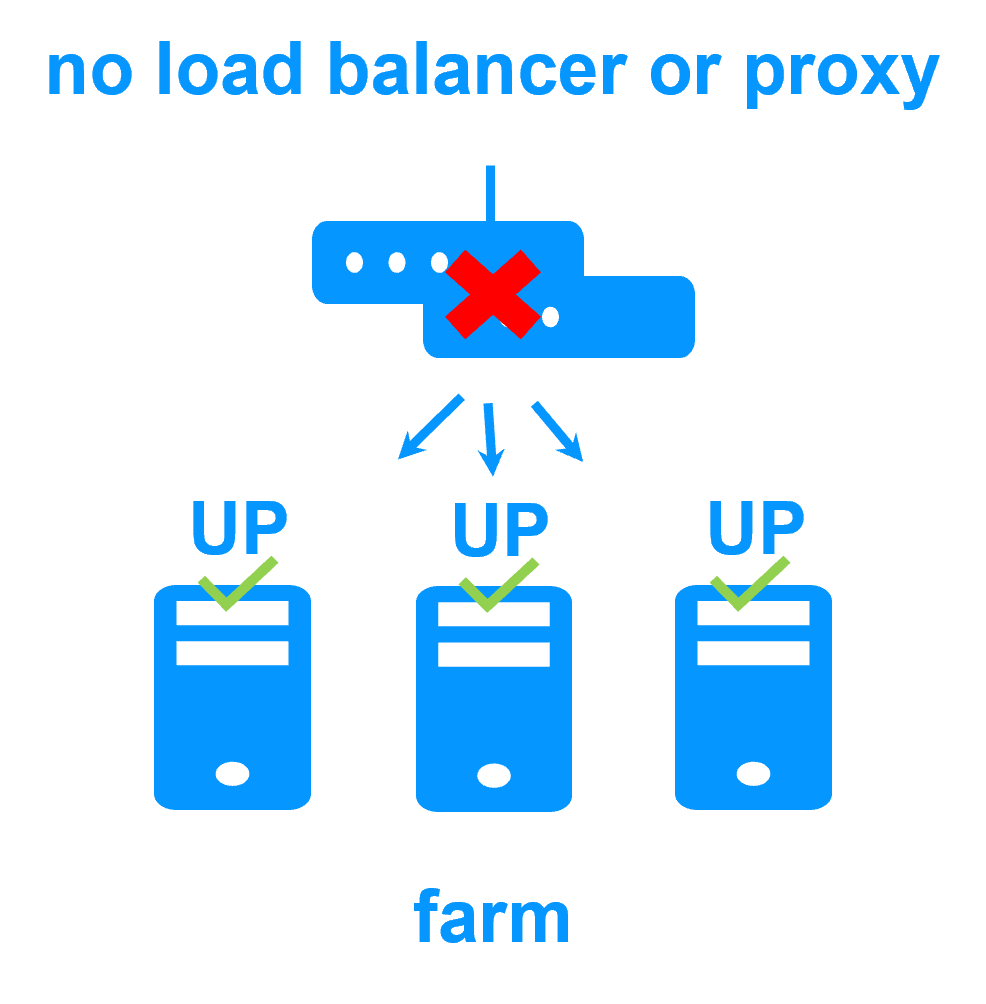 |
|
All clustering features
More info >
 |
|
Remote sites and virtual IP address
More info >
 |
|
Uniform high availability solution
More info >
 |
|
Software clustering vs hardware clustering More info > |
|
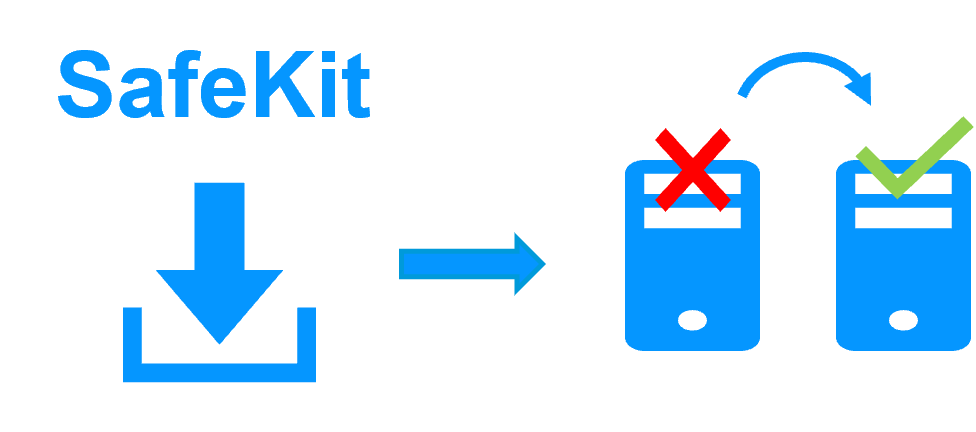
|
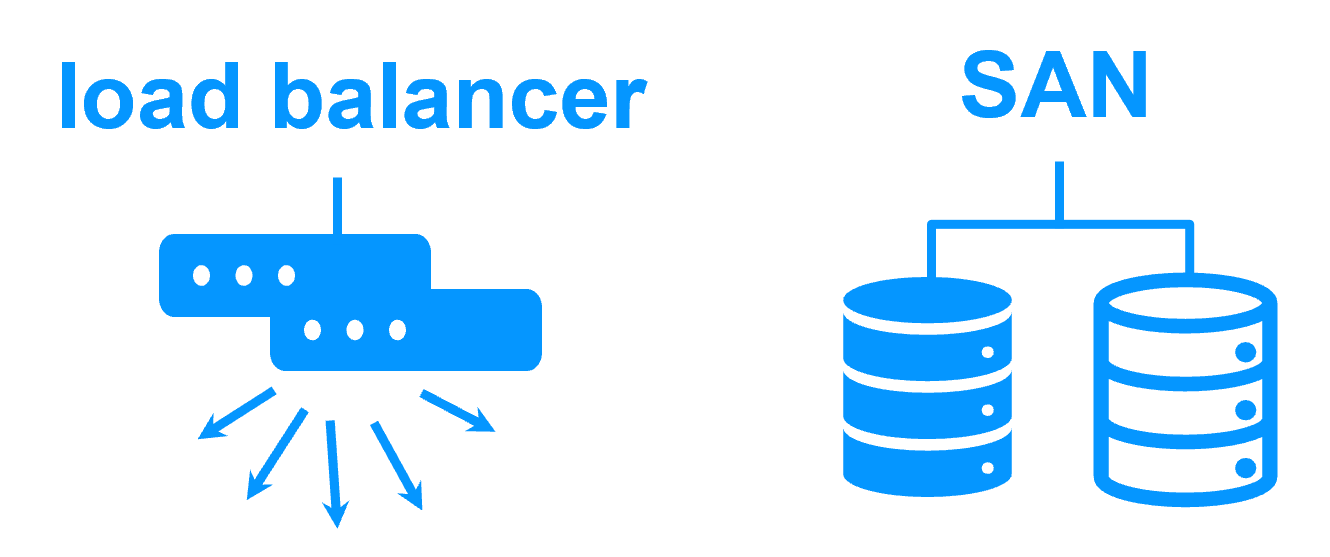
|
Shared nothing vs a shared disk cluster More info > |
|

|
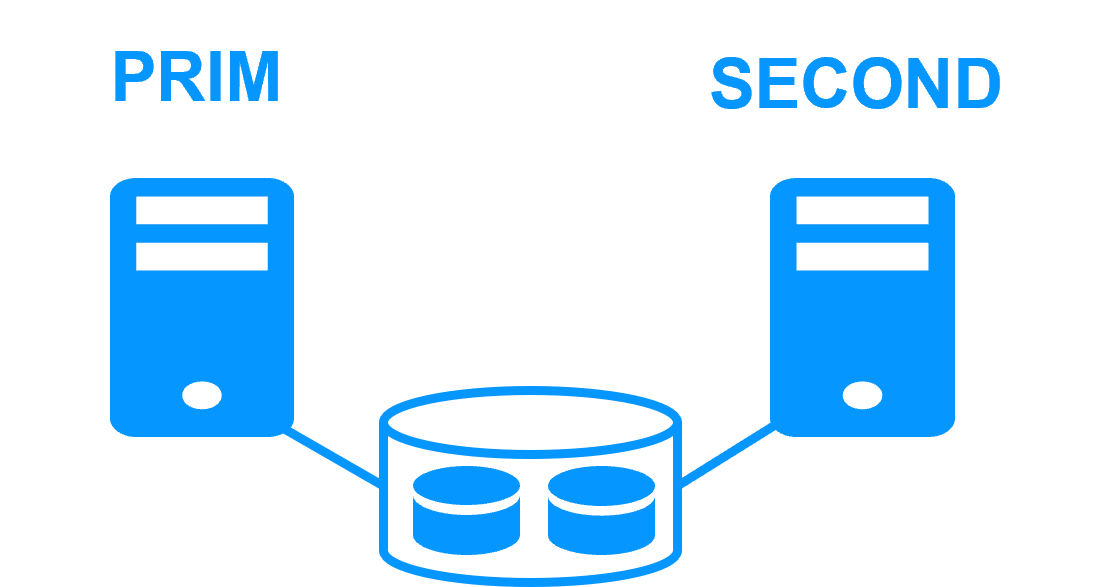
|
Application High Availability vs Full Virtual Machine High Availability More info > |
|

|

|
High availability vs fault tolerance More info > |
|

|
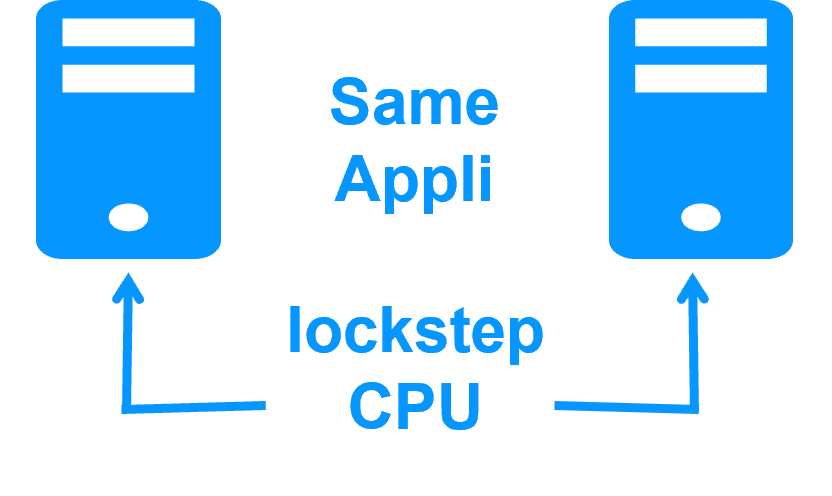
|
Synchronous replication vs asynchronous replication More info > |
|

|
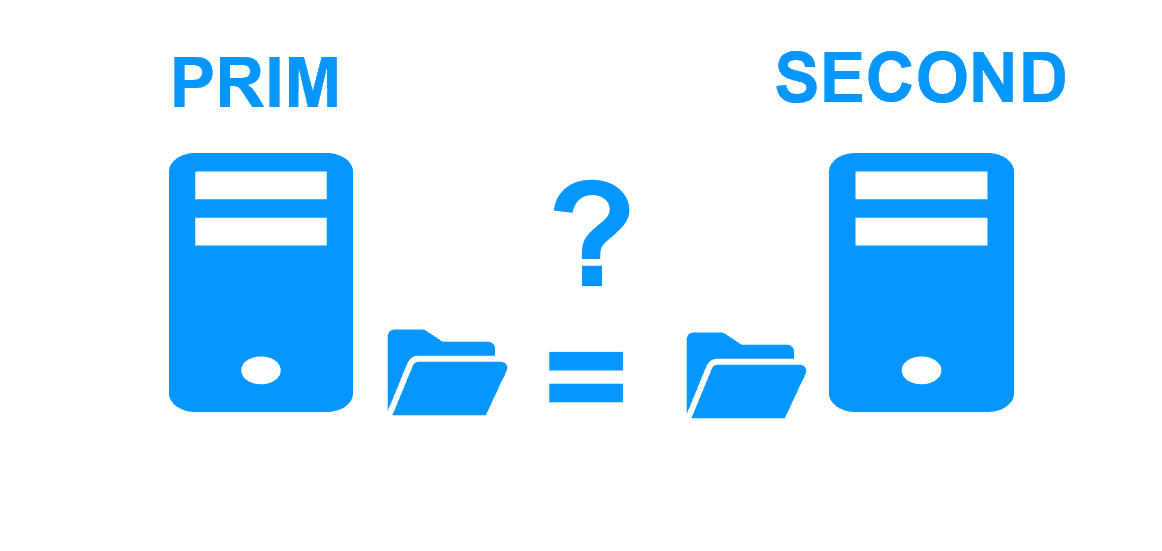
|
Byte-level file replication vs block-level disk replication More info > |
|

|
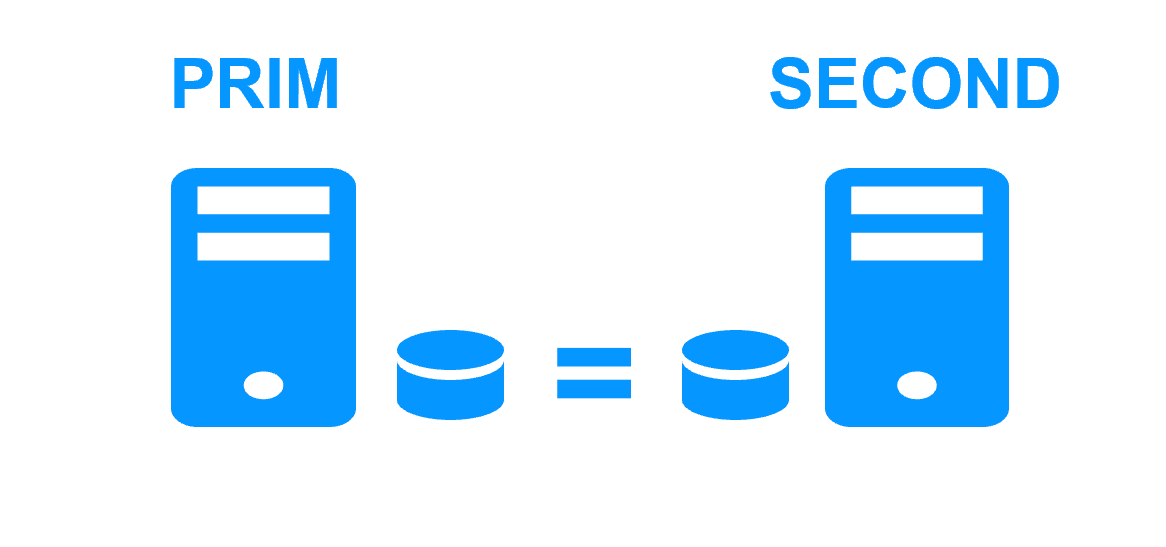
|
Heartbeat, failover and quorum to avoid 2 master nodes More info > |
|

|

|
Virtual IP address primary/secondary, network load balancing, failover More info > |
|

|

|
